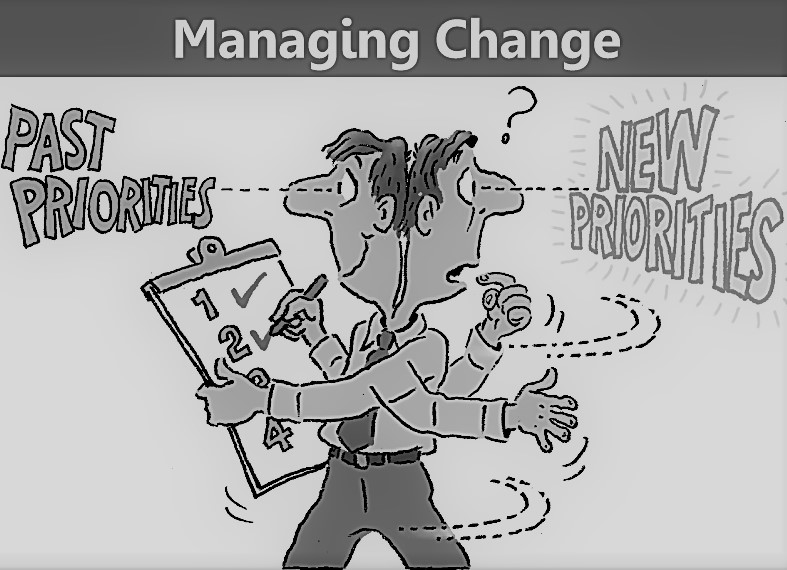INVITING APPLICATIONS
14th SSF EXCELLENCE AWARDS & RECOGNITION – 2025
LAST DATE: JUL-25 | APPLY NOW
Change is the only constant in life – Heraclitus, c. 535 - 475 BC.
In my ~30 years of corporate life, I have faced many corporate situations of change that have left me baffled for a cause or a solution. Each one these ‘situations’ have been unique and novel. At times, such change events occur without any warning at all, and at other times one is expecting the situation, but is unable to do anything to prevent it.
Over the years, I have realized that the best test of maturity and leadership is not how one manages the business but how one manages abnormal situations, such as change.
One witnesses several forms of change constantly – in the corporate world, in personal life and in the society. Managing change of any type is always difficult but change that impacts people and their lives due to direct or indirect external action is always the most challenging. This happens all too often in the business world, especially in the world of process transformation, of which I am a member.
Consider the following two extraordinary moments of plight:
- Within a few weeks of my joining as a Director Operations with a German retailer to set up a shared service centre, I was welcomed by black flags by works councils in Germany.
- As part of organizational imperatives, I was once tasked to disband an entire Business Services function of over 4,000 people for the world's largest agro-chemical company.
Let me share some details.
Situation 1
I joined a progressive organization where my principal task was to oversee the corporate transformation program. As a part of the program, we were to transition work from their European centre into India. Logically this meant that eventually a bunch of Germans would lose their jobs. To top it all, the Germans, being the subject matter experts, were to plan for and train the staff in India. Clearly it was a worrying situation for the Germans.
The day I landed in Germany, I was confronted with black flags and protests by the works councils. It was a distressing situation for me as this incident happened within the first few weeks of my having joined the organization and I had no prior inkling of it. The protests were a direct result of the company’s decision to set up a centre in India and migrate the functions there in bulk. The Indian colleagues were being looked at very differently and understandably not welcome.
We began to see various instances of non-cooperation and defiance. For instance, the works councils took an informal decision to speak only in German language, creating significant communication barriers. The process suffered greatly.
Several rounds of discussions were carried out.
The management continuously demonstrated that they are sympathetic to the local issues and are doing their best to mitigate severe impact, if any. Joint teams were specifically tasked to find common ground so that employees in Germany could move to higher and different jobs. A sense of ownership and oversight was given to the German teams. Their role in corporate restructuring was highlighted and applauded. Over time, the situation was reversed, and the German team took pride in imparting training and knowledge to their remote colleagues in India.
Situation 2
The second situation too was one of transformation, except at a different scale. Here, as a part of a global decision, we were required to wind up an entire Business Services function of over 4000 people, belonging to a large multinational company. The function had been performing well for a decade already. The organization was coming to terms with a takeover and it was the decision of the new management to split the company into two business lines. This decision coupled with that of disbanding the Business Services function had a far-reaching impact on the shared services centre that I was leading.
One fine day I was informed that all my managers, peers and other senior executives will be leaving the organization and that the announcement would be out in the next few days. This information came as a rude shock to me. Meanwhile, the grapevine was active. All kinds of news began to percolate from the HQ office and a lot of unfiltered information began flowing through various channels leading to speculation and an atmosphere of uncertainty. I had to manage the drastic change with no one to talk to as all my seniors were leaving too – and they had more questions than answers.
As a responsible people leader I had to put my thoughts together with the central leadership and the HR team and work out a communication strategy to minimize the impact and the fallout.
As you can well imagine, both the above situations were connected to change management that impacted people on a large scale.
In these challenging times, we are clearly experiencing this ‘constant’ constantly. Leadership all across the globe is being tested for their skills in successful management of change. While this is a privilege for leaders, depending on the individuals concerned, such an opportunity could be considered a boon or a bane.
Successful management of change is crucial to any organization in order to survive and succeed, especially in the present highly competitive and continuously evolving business environment.
Change is imperative – forced by enhancement in technology, change in operating strategy, as a result of a merger or consolidation, or by drastic change in the social environment, such as the covid pandemic.
Although there is a clear understanding in the importance of managing change professionally in organizations, it is widely acknowledged that up to 70% of change initiatives fail. Within the growing literature on change leadership there are several assertions indicating that the root cause of change management issues is leadership behaviour.

While constantly dealing in an era of uncertainty, I have personally followed four key lessons while managing change:
-
Transparency, clear outline and clear communication
- Create a detailed plan to help manage change
- Formulate a diverse team to work on managing change
- Create a clear operational and communication strategy; announce widely
- Clearly address the impact of the change and what it means to everybody
I found this very appropriate in the 2nd situation when entire GBS organization was being disbanded and people in the centre and those associated globally were completely in the dark about their future.
-
Create a sense of urgency and empower the teams
- Identify obstacles to change, such as structure or systems blocking the change
- Encourage lateral thinking and risk taking; remove fear of failure
- Examine the realities - both internal and external
This above guiding principles came handy to me several times while facing hostilities and uncertain situation, not planned for. One can plan for expected situations, but at times unforeseen changes occur without a warning bell. The principles of thinking outside the box, examining ground realties and not being afraid of failure can provide unprecedented solutions to complex issues.
-
Look for short term wins
- Plan and execute visible improvements
- Reward and recognize people who deliver
- Actively promote team culture
This worked when we faced an uncertain future in the 1st situation – break the strategy into steps and execute them well.
-
Be Agile; fail fast and learn fast
- Experiment boldly; never mind the failures
- Short circuit the decision-making process
- Create empowered teams
- Document failures, communicate learnings, and ensure the same failure is never repeated
All these principles were effectively deployed in both the above-cited situations. We did not know what the final outcome would be, but we decided on a clear strategy early in the process of change management and started its execution. On the way we kept learning and improving on what worked and what did not. We did not have any pre-planned solutions so being agile surely helped.
While applying these key lessons, if the leaders are open to adapt and lead the change fearlessly, while working with the impacted employees, change becomes easier to implement.
I have found that adopting the four lessons of change clinically, coupled with a deep sense of humility and people management, has not only result in a desirable outcome each time, but I have also emerged as a strong leader.
ABOUT THE AUTHOR

Sanjeev is a senior finance professional, who has led fortune 500 shared services in Finance, IT, HR & Real Estate, Strategy & Transformation. He is a business leader with more than 2 decades of diverse experience in managing multi-geography service delivery; transformation in HR, IT and digital finance; setting up shared services/ BPO centers; shareholder agreement creation/ negotiation; and talent management & succession planning. He is a Chartered accountant, Cost Accountant, Company Secretary, M Phil, and has worked with Fortune 500 companies like Syngenta, Metro Cash & Carry, Hewlett Packard, Accenture, Standard Chartered Bank and American Express.



 Ask an Expert
Ask an Expert



